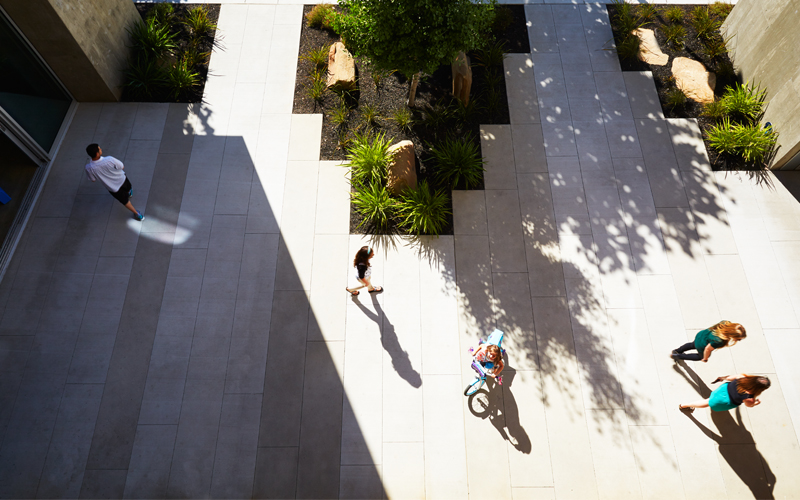Professional Practice
Using Low-Impact Materials: Sustainable Concrete
 Sustainable site materials used in the landscape include recycled-content steel and high fly-ash concrete. ËżąĎĘÓƵ 2016 Professional Residential Design Honor Award. The Rivermark, Sacramento, California / Fletcher Studio.
Sustainable site materials used in the landscape include recycled-content steel and high fly-ash concrete. ËżąĎĘÓƵ 2016 Professional Residential Design Honor Award. The Rivermark, Sacramento, California / Fletcher Studio.Concrete is the most widely used building material in the world, thanks to its variety and durability. However, manufacturing cement, the binding material in concrete, is a highly energy and water-intensive process. The sheer volume produced, over 2 billion tons per year globally, is detrimental to the environment. The manufacturing of cement accounts around emissions globally. Furthermore, supplies of limestone, a core ingredient in cement, are being depleted. Concrete also poses a problem for construction material disposal.
To avoid sending useful materials to the landfill, conserve natural resources, and reduce a projectˇŻs carbon footprint, recommends landscape architects specify sustainable concrete from manufacturers using supplementary cementing materials, like fly ash ¨C a byproduct of coal-fired power plants. Landscape architects and designers should reuse concrete from structures on the existing site, like crushed concrete as an aggregate base. Concrete that incorporates recycled materials, like crushed glass or woodchips, are a more sustainable and use less cement than traditional pavers.
With SITES-certified projects growing in application and use, manufacturers are increasingly offering sustainable concrete alternatives, such as permeable concrete material, pavement systems that allow for more water infiltration into the ground, and recycled aggregate material. For example, James Corner Field OperationsˇŻ in Chicago achieved SITES Gold certification in part by working with a manufacturer to develop and implement recycled content in the pavers.
There are a number of ways residential projects can use recycled and sustainably-sourced concrete to achieve SITES certification. SITES recommends designing to minimize impervious surfaces by specifying materials for hard surfaces like permeable concrete, asphalt, and pavers. SITES also recommends an open-grid pavement system, or concrete-grass lattice, as a way to manage urban heat island effect. In addition to recycling on-site concrete and using concrete with recycled material, designers should also consider using concrete that is locally sourced.
There are a number of . For example, ˇ°self-maintainingˇ± or ˇ°self-healingˇ± concrete like BacillaFilla, which is an engineered microbial glue that is applied with a spray and can repair cracks in concrete, and bendable concrete that is less brittle than traditional concrete and can self-heal with the presence of air and water.
Sources: , Columbia University
Organizations
Resources
, Montgomery County Planning Commission
, World Wildlife Fund
, International Energy Agency
, Concrete Network
, Milwaukee Metropolitan Sewerage District
Research
, Tarun R. Naik, University of Wisconsin, Milwaukee, 2005
, C. Meyer, Columbia University, 2002
ˇ°,ˇ± Paige Gilchrist, Lark Books, 2002
ˇ°,ˇ± Carlo Pellegrino & Flora Faleschini, Springer, 2016
ˇ°,ˇ± Gajanan M. Sabnis, CRC Press, 2015
ˇ°,ˇ± Meg Calkins, Wiley, 2008
Innovation Resources
, Landscape Architecture Magazine
, Guardian Sustainable Business
, Smart Cities Dive
, Chemistry World, 2008
, Phil Seabrook & Kevin Campbell, Peng, EcoSmart Concrete
, Phys.org
Projects
The Rivermark, Sacramento, California
Fletcher Studio
, Cambridge, Massachusetts
Julie Moir Messervy Design Studio
Lee Landscape, Calistoga, California
Blasen Landscape Architecture
High Point, Seattle, Washington
Mithun